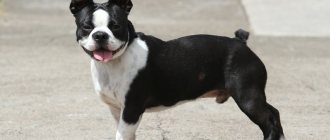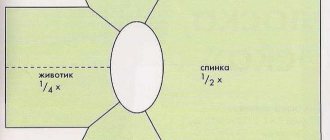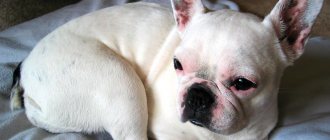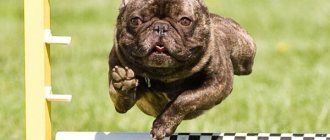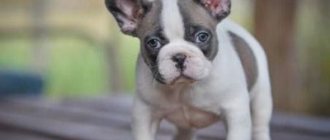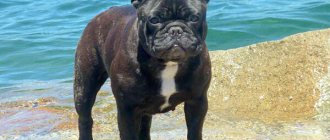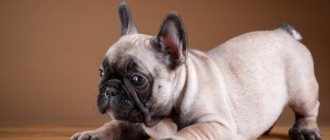The French Bulldog is a selectively bred breed, so they are more susceptible to various diseases than other dog breeds. Probably only pugs are ahead of them in terms of the number of diseases. They have a number of specific characteristics and hereditary predispositions that are unique to them.
The most common are problems with the spine, skin, paws and eyes. Mostly, pathologies begin to appear after 5–6 years of a dog’s life, but they can appear earlier. The fundamental principle of diagnosis here is immediate contact with a veterinarian, since self-diagnosis, and especially treatment, can lead to the most disastrous consequences.
If any signs of illness appear in your dog, you should contact your veterinarian for tests, a diagnosis and treatment.
How can you tell if your dog is sick?
First of all, you should pay attention to the dog’s atypical behavior. She may start to worry and whine. Also refuses to eat or sleeps poorly. These are all signs of a malfunction of the body. Particular attention should be paid to the French bulldog puppy. The puppy should be quite vigorous and active, cheerful and playful. He should not have excessive discharge from his eyes or nose, they should be clean.
If the “baby” is lethargic and apathetic, his nose is dry and hot, this is the first sign of an incipient illness. First of all, you need to measure the temperature. It is measured by inserting a thermometer into the dog's rectum. A normal temperature is considered to be between 38 and 39 °C. Even a slight deviation of half a degree indicates the presence of a serious disease. This requires the intervention of a qualified veterinarian. Further in the article, the main signs and types of ailments that the owner of a French bulldog may encounter will be discussed.
Eye care rules
Normal vision in French bulldog puppies develops by the age of one and a half months, when they begin to distinguish objects well, navigate in space and follow moving objects.
However, unfortunately, over time, the “French” develop myopia . This happens closer to a year. It is important for the owner not to aggravate this process with poor visual care and not to speed it up due to oversights in the pet’s health.
A healthy dog's eyes are shiny but not watery. But when walking or being in dusty rooms, particles of dust, dirt, or small fragments of foreign objects or bodies may get into your eyes. Because of this, small clots of purulent discharge accumulate in the corners of the eyes.
Therefore, after walks, as well as in other cases, when this discharge appears, it is necessary to clean the dog’s eyes with a piece of clean cotton cloth or a napkin, removing this particular clot.
Important! Cotton wool can leave fibers in the eye, so its use is not advisable.
Discharge from the eyes may turn the color of the fur underneath pinkish-brown or coat that fur with a brown, sticky substance. This exudate in itself is not dangerous, but the color of the coat indicates the action of bacteria and yeast. Therefore, for a healthy dog, it is enough to wipe the eyes and fur underneath them every morning with a clean piece of cotton cloth or a napkin soaked in warm, clean water.
If discharge from the eyes begins to bother the dog, a consultation with a veterinarian will help to figure out the cause: lacrimation may be associated with irritants affecting the organs of vision, and infectious diseases of the eyes are also possible.
Excessive lacrimation may occur due to strong wind or draft. In this case, you need to wipe your eyes from the outer corner to the inner corner with a soft cloth or napkin. It is not recommended to use synthetic types of fabrics for these purposes. You should also monitor your eyes in the future and if excessive tearing occurs again for no apparent reason, seek help from a specialist.
Dermatitis
Dermatitis is an inflammation of the skin caused by the presence of an allergen. French bulldogs have a low immune threshold and they are prone to a strong reaction of the body to any irritants. The most common is atopic dermatitis. It is visible on the dog, and she gives it away by constant scratching. It is characterized by inflammation and rashes in certain areas of the skin, the appearance of blisters on the abdomen, between the fingers, and on the testicles.
Light-colored dogs are more likely to suffer from skin diseases, so they require more careful hygiene.
Allergy
Skin diseases are easy to treat, but problems arise when self-diagnosing and determining what exactly causes dermatitis. A veterinarian's consultation is required here. Characteristic symptoms include the following:
- Restless behavior.
- Skin rash.
- Partial hair loss.
- Red spots and swelling.
- Edema.
- The appearance of pustules, ulcers and wounds on the body.
- Constantly itches.
- Heavy breathing and constant sneezing.
In addition to the body and head, the pads on the paws, the interdigital area and the entire length of the claws are also affected. Next, you can familiarize yourself with the different types of allergies.
Food
Photo of allergy manifestations
The dog may feel sick, refuse to eat, and have diarrhea. The way to combat this is to review foods from the diet and eliminate them one by one until the source of the allergen is identified. Itching is relieved with special tablets and ointments, drops are placed in the eyes and wiped with lotion.
Signs of a food allergy may include:
- The appearance of red spots on the skin.
- Itching.
- Dandruff rash.
- Edema.
- Teariness and redness of the eyes.
- Inflammation of the mucous membranes.
- Irritable or depressed behavior.
Medication
Taking medications by your pet during treatment may cause the body to have an allergic reaction to the tablets. It is also possible that the dog accidentally found and ate medications.
Chemical
Inappropriate cosmetic and hygiene products, low-quality and allergenic shampoos, all this leads to the risk of allergies. It is necessary to periodically do wet cleaning and ventilate the room.
On parasites
Parasites are very dangerous to the health of not only dogs, but also people who are in close contact with them . The bulldog's resting area must be kept clean, bowls must be washed regularly using various detergents, food and water must be of good quality. In this case, the possibility of infection by parasites is very small. External parasites (ectoparasites) usually live on the dog's skin and fur. There are several types:
- Fleas.
- Lice.
- Ticks.
The bulldog begins to itch constantly and becomes nervous and aggressive. Sores, redness on the skin and bald spots in the fur appear on the body. Fleas bite your dog and make him itch. She begins to chew the base of her tail. As a result, by ingesting fleas and scraps of fur, she can become infected with tapeworms. A clear sign of an infestation is the presence of “flea dirt” (grainy black growths) in the fur.
Fleas can live not only on the dog, but also in the house. The dog needs to be treated with insecticidal preparations and the house must be thoroughly cleaned. Lice are harmful not only to dogs, but also to humans. They are contagious and clearly visible on the body. You can get rid of them using insecticidal shampoo, but it is still better to consult a doctor for advice.
Ticks are divided into 3 types:
- Demodex.
- Sarcoptes.
- Encephalitis.
The first two cause scabies. Demodex is extremely contagious and can only be detected under a microscope. Lives in hair follicles. The mite moves in the upper layers of the skin, causing itching. The dog begins to itch, its hair falls out and wounds appear on its body. The encephalitis tick is visible to the naked eye.
The bite does not cause irritation and is imperceptible to the pet. The danger is that it is a carrier of diseases. Therefore, after walks, especially in the forest, it is necessary to check the dog for ticks, especially on the ears and between the hind legs. Having found a parasite, you need to drip medical alcohol or sunflower oil on it and remove it with tweezers.
Fungus
Fungal diseases can appear on any part of a bulldog's body. This is mainly due to reduced immunity, as well as thin and delicate skin. Careful care is primarily required in the folds of the skin, where dust and dirt usually accumulate. They need to be wiped with cotton pads or a soft cloth moistened with hygiene lotion or clean water. It is not possible to identify such a lesion on your own. To do this, the clinic takes scrapings and examines them under a microscope. The main signs of the onset of the disease are:
- Redness on the skin, the appearance of acne.
- Hair loss.
- The appearance of an unpleasant odor.
- The dog begins to itch a lot.
- Ringworm on the body.
Treatment in these cases is carried out with ointments, anti-fungal tablets, and washing the dog’s body with hygienic shampoos. In any case, it is better to consult a veterinarian.
Fungal diseases are very similar in symptoms to allergies, but treatment methods are different.
Treatment of French Bulldogs
(1) professional, used exclusively by certified veterinarians and requiring professional skills and knowledge, and
(2) general, which are available to most ordinary dog lovers and are intended to provide veterinary medical care to the animal at home.
Ideally, treatment of animals should be carried out under the supervision of a veterinarian who is able to accurately diagnose the disease, the degree of its development, prescribe effective drugs and determine their optimal dosage.
Conservative treatment of conjunctivitis is ensured by the introduction into the animal’s body of medications of narrowly targeted action (dexamethasone, Tinset, betnesol, teralen, interferon, sofradex, etc.).
Treatment of follicular conjunctivitis in dogs often involves the use of polymer films based on (1) sodium sulfapyridazine or (2) kanacimin, or more radical and painful methods (cauterization of the conjunctiva, for example).
The primary symptoms are a constant flow of tears, which should alarm the owner.
The first thing to do is wipe your eyes with cotton wool soaked in boiled water or chamomile infusion. Limit walking for a while so that the wind does not blow out sore eyes, and dust and weeds do not irritate the mucous membrane. If the tears do not stop, and redness appears, then you cannot postpone a visit to the veterinarian. Only a specialist can prescribe the necessary therapy.
How to treat conjunctivitis in a dog at home? The course of treatment includes antibiotic ointments and anti-inflammatory eye drops. The most common drops: sodium sulfacyl, chloramphenicol drops, kanamycin and sofradex drops. Eye drops should be applied at least four times a day.
For conjunctivitis, effective ointments:
- tetracycline or chlortetracycline;
- etazolic.
The new generation of treatment involves ophthalmic medicinal films, which, when attached to the conjunctiva, dissolve and produce a therapeutic effect.
Severe hair loss
Natural hair loss in a dog occurs during seasonal molting, or during the period of age-related changes in the puppy. In older dogs, this may occur due to the deterioration of coat quality with increasing age. Any other excessive shedding should alert the dog owner. There may be several reasons for this:
- Lack of vitamins and nutrients in the body.
- Intestinal parasites are helminths.
- Genetic predisposition to shedding.
- Allergy.
In any case, to identify the cause and prescribe treatment, consultation with a professional is required.
Red and watery eyes
Redness and tearing of the eyes can be caused by 3 reasons.
- Infection.
- Injury.
- Progressive disease.
When an infection occurs, the dog whines, rubs its eyes with its paws, blinks and worries for no reason. In this case, you need to carefully rinse your eyes. If this does not help, then the next cause may be injury. A characteristic sign is a bruise in the eye. The most difficult to visually identify are progressive diseases: retinal detachment and cataracts. At a late stage it is expressed in white and cloudy membranes of the eye.
An advanced infection can deprive a dog of his vision.
Types of conjunctivitis and their manifestations
The most common types of conjunctivitis are:
- purulent;
- catarrhal;
- fibrinous;
- follicular;
- phlegmonous;
- allergic;
- keratoconjunctivitis.
According to the nature of the course of the disease, there are (1) chronic and (2) acute conjunctivitis.
Purulent conjunctivitis is accompanied by thick yellowish discharge from the eyes.
With catarrhal conjunctivitis, redness of the mucous membrane of the eye is first noted, which is replaced by swelling and, somewhat later, the release of serous fluid.
Fibrinous conjunctivitis is characterized by protrusion (layering) of the conjunctiva over the surface of the eyelid.
Follicular conjunctivitis is characterized by the presence of multiple distinctly red follicles on the surface of the third eyelid against the background of profuse lacrimation and gradual redness of the entire inner eyelid.
Keratoconjunctivitis is characterized by a sharp decrease in the amount of tear fluid and “drying out” of the mucous membrane of the eye.
Ears
According to statistics, ear diseases in dogs account for up to 20% of all diseases. The most common disease is otitis media (ear inflammation). Basically, the disease occurs in the middle and outer ear; inflammation of the inner ear is extremely rare. The main symptoms of the onset of ear disease are:
- The dog shakes its head and tilts it to the side.
- He often scratches his ear and shakes his head.
- Experiences pain when pressing on the base of the ear.
- The appearance of an allergic rash.
- Redness and swelling.
- Discharge of pus.
- The dog does not respond to sound (you can check by snapping your fingers near the ear).
- Sagging or creasing. (result of a fall, injury or fight). The dog whines and presses his ear to his body.
- General depression, lethargy, lack of appetite, fever.
There may be several reasons:
- Mechanical damage. As a result of a fight with other dogs or simply a bruise, mechanical damage to blood vessels can occur and, as a result, the formation of a hematoma. Depending on the degree of damage, the doctor chooses surgical or conservative treatment. If treatment is neglected, the ear can become deformed and lose its shape for life.
- Fungus. If a fungal infection (otomycosis) is suspected, scrapings are first made in the laboratory in order to determine the type of fungus that caused the lesion. Basically, the cause of otomycosis is yeast fungi. Treatment in this case consists of prescribing a drug that destroys the vital activity of the fungus. The starting point for the onset of the disease can be hypothermia, reduced immunity, poor nutrition, and an allergic reaction.
- Ear mite. (Otodectes synotis - in Latin). Causes severe inflammation inside the ear. Otodecosis is accompanied by itching, the appearance of ulcers, and crusts. Infection occurs through contact with sick animals.
Only a doctor should treat otitis media. It is necessary to make an accurate diagnosis and identify the causative agent of the disease. Self-medication is inappropriate here (it is difficult to make a diagnosis at home) and can lead to various complications, such as rupture of the eardrum, meningitis and the death of the pet. Important preventive measures are regular ear examinations and hygienic cleaning.
How to recognize conjunctivitis in dogs
Depending on the type of disease, distinctive symptoms are distinguished.
1. Catarrhal conjunctivitis. It all starts with redness of the connective membrane of the eye, and is later accompanied by swelling. Serous fluid begins to leak from the eyes. This form of the disease is acute, so it can become chronic.
2. Purulent conjunctivitis in dogs. The onset of the disease is characterized by obvious discharge from the eyes, which over time becomes thicker and turns yellow. The conjunctiva begins to turn red and swelling appears. The disease causes severe discomfort, which makes the animal depressed.
3. Follicular (allergic) conjunctivitis in dogs. First, the conjunctiva becomes inflamed, and dark red follicles are observed on the inner surface of the third eyelid. It is distinctive that this form often becomes chronic and can cause exacerbations for several years.
Causes of hind leg failure
One of the characteristics of the French Bulldog breed is weak hind legs. This manifests itself in lameness, wobbling gait, and paralysis of the hind limbs. Such signs should be a reason to immediately consult a doctor. Self-treatment is strictly not recommended. Otherwise, it may lead to complete loss of movement. There are several reasons for the appearance of pathology:
- Damage to the intervertebral discs (displacement, destruction). Symptoms of discopathy: wobbly limbs, the dog is trembling, attacks of pain in which the dog freezes in one place.
- Diseases of the hip joints. Weakness of the limbs due to dysplasia decreases after exercise and increases after the dog rests. The destruction of the joints occurs slowly and unevenly, so the bulldog may first limp on one, and then on both legs.
- Osteochondrosis and other diseases of the spine.
- Myositis – as a result of heavy physical exertion (muscle inflammation).
- The spinal cord is affected.
- Arthritis and arthrosis of the joints.
- Wedge-shaped vertebra. A wedge-shaped vertebra compresses neighboring vertebrae, and they, in turn, put pressure on the spinal cord. Accurate diagnosis in a veterinary clinic is necessary, because... The symptoms of the disease are similar to discopathy. The method of treatment is surgery.
- Patella luxation (displacement of the kneecap). Surgery required.
- Perthes disease (damage to the head of the femur). Signs: whining in pain, lameness, tucking of the hind paw, the affected limb is visually shorter.
Prevention of eye diseases
Prevention of eye diseases in French bulldogs involves, first of all, a daily thorough examination to identify possible problems, as well as following the rules for caring and feeding the animal to maintain its immunity.
If signs of eye disease are detected in a “Frenchman,” timely seeking medical help will contribute to a speedy recovery of the pet and minimize damage to its health, as well as saving nerves and money for its owner.
This is interesting! The structure of the eyes of French bulldogs is such that they cannot distinguish colors, and also sometimes distinguish flat objects from three-dimensional ones.
Due to these features, injuries and damage to the eyes can often occur . You should keep this in mind and protect the area surrounding the dogs, protecting them from possible injuries during walks or in other places where they stay.
Since a strong wind flow or drafts can lead to excessive lacrimation or inflammation of the organs of vision, you should monitor the direction of the wind when walking and, if necessary, adjust the places or times of walks. For the same reason, you should not allow “Frenchies” to stay in a draft for a long time on the street or in your home, or allow them to stick their muzzle out of the window of a moving car.
To prevent the formation of brown crusts under the eyes and further infection of these areas, it is enough to wipe these areas once a day with a damp cloth or napkin, and also cut the hair around the eyes short.
You should not use any detergents to clean the eyes and fur around them to avoid irritation of the organs of vision; it is enough to use clean, warm boiled water or special products designed to care for your pet’s eyes.
Heart
Heart failure is expressed in overwhelming cases in the form of problems with the mitral valve. This disease is typical for older dogs, but can begin earlier, at the age of 4–6 years. Signs of the onset of the disease are:
- Fast fatiguability.
- Dyspnea.
- Fainting.
- Serious pulse arrhythmia.
- Cough.
- Wheezing.
Diagnosis in this case is carried out using a cardiogram, ultrasound - cardiography and chest x-ray. Blood thinners, various vitamins and supplements, and sedatives are prescribed. Slow walks and frequent rest, diet and a calm home atmosphere are also necessary.
Causes of a runny nose
The manifestation of a runny nose in a “Frenchman” can occur in acute or chronic form. In acute rhinitis, treatment should be prescribed by a doctor. In this case, you need to start doing this immediately to avoid the disease becoming chronic. The main symptoms of the onset of the disease:
- The dog often sneezes, sniffles, and appears short of breath.
- Redness of the mucous membrane and eyes.
- Strong discharge from the nose, snot is initially liquid and transparent, then becomes thicker.
- Loss of appetite, up to complete refusal.
The main causes of rhinitis in dogs are:
- Allergies to animal care products, as well as pollen, dust and mold. Causes copious clear nasal discharge.
- Adenovirus infection is a disease caused by a virus of the Adenovirus family. Characterized by inflammation of the mucous membranes of the respiratory tract. Accompanied by swelling of the mucous membrane, wheezing, diarrhea and vomiting, and fever.
- Contact with the mucous membrane of various synthetic irritants, household and other chemicals. Characterized by sneezing and scratching the nose.
- Foreign objects entering the nasopharynx.
- The presence of polyps and tumors in the nasopharynx.
The sooner you contact a veterinarian, the easier the disease will progress. The doctor takes tests from the dog and makes an accurate diagnosis. Treatment for a runny nose involves taking antibiotics and medications to support the immune system. During this period, it is necessary to limit contact with other animals and ensure that the animal does not have an allergic reaction to medications.
Eye care for illness
If your dog has excessive lacrimation, redness, clouding of the eyes, or the presence of profusely secreted purulent exudate in them, this is a reason to consult a veterinarian for advice and examination, as these symptoms may indicate an eye disease in the pet.
Important! Often, dogs with such almost bulging eyes experience prolapse of the third eyelid, as well as eye injuries due to punctures and foreign bodies. There are frequent cases of conjunctivitis caused by infections.
Eye irritation, blockage of tear ducts, inversion of eyelashes or eyelids, abnormal eyelid structure - all this can cause profuse and frequent tearing, which, together with bacteria and fungi, can lead to a dog’s eye disease and long-term treatment and recovery. Therefore, if the above signs are detected, going to a specialist will make life easier for both the owner and his pet.
With an allergy, prolonged and profuse discharge from the eyes is possible, as well as sneezing, restlessness, and itching on other parts of the dog’s body. It is necessary to analyze the dog’s condition and remove the source of the allergy from his environment. Antihistamines, sorbents, and hypoallergenic foods are used for treatment.
Watery eyes caused by blocked tear ducts, inverted eyelashes or eyelids, or abnormal eyelid structure can sometimes be treated only with surgical intervention, the need for which can only be recommended by an experienced specialist. He will also prescribe restorative therapy.
If a foreign body is detected in the dog's eye, you cannot remove it yourself, but you must contact your veterinarian. Under sterile conditions, the doctor will help remove the foreign object from the eye and prescribe appropriate healing, antimicrobial and anti-inflammatory drugs. It should be remembered that it is inadmissible to use healing drugs before removing the foreign object from the eye.
Only a doctor can diagnose a dog with conjunctivitis, and only after appropriate tests. Symptoms of this disease are profuse purulent discharge from one or both eyes, the formation of dried crusts on the eyelids and eyelashes.
For treatment, microbe-sensitive drugs and restorative therapy are used. The crusts are removed with a soft cloth or napkin soaked in warm boiled water.
Important! Do not wash dogs' eyes with solutions of aggressive agents or tea.
When prescribing eye drops, they need to be instilled with a pipette into each eye, for which you need to fix the dog, then use the fingers of one hand to slightly push the eyelids apart, and with the other hand, instill drops into the eye, bringing the pipette to a distance of 5 mm. from the eyeball. It is better to apply the gel to the inner edge of the eye.
Snore
A completely healthy French Bulldog should breathe almost silently or with a slight snore. This is considered normal and is not a cause for concern. The reason for this peculiarity of the respiratory system lies in the presence of a dog with a large head and a flattened muzzle. Pathology can be expressed in constant wheezing, grunting and whistling of the dog. These signs indicate an abnormally shaped dog's nasal septum or the onset of brachycephalic syndrome.
An operation to correct the nose can be performed in a veterinary clinic, after which the dog’s condition improves significantly and it begins to breathe fully. It is necessary to protect your dog from heatstroke on hot days. Under no circumstances should you leave your dog in the car if the outside temperature is more than +25 °C.
If the owner was unable to protect the dog, and the first signs of overheating appeared (blue tongue and hoarse breathing), it is necessary to apply a cold compress to the head or pour cold water on it and immediately take it to a veterinary clinic. Unnaturally heavy and noisy breathing with an open mouth, copious sputum production may be signs of blockage of the larynx or trachea, narrowing of the nasal sinuses, or brachycephalic syndrome. Such symptoms require immediate surgical intervention.
Malformation of the thoracic vertebrae in French bulldogs
Malformation or wedge-shaped vertebrae in French Bulldogs.
More and more often in the practice of a veterinarian we encounter such congenital pathology as malformation (underdevelopment) of the thoracic vertebrae in French bulldogs. The disorder occurs almost exclusively in this breed and much less frequently in others. The abnormal shape of one or more thoracic (much less frequently lumbar) vertebrae creates conditions for degenerative processes in the spine, its biomechanics and, possibly, secondary compression of the spinal cord.
The essence of the problem is the abnormal, wedge-shaped or trapezoidal shape of the vertebral bodies (normally the vertebral body is rectangular). This shape promotes displacement of the vertebrae relative to each other, as well as relative to adjacent healthy vertebrae. This process of displacement may remain unnoticed throughout the dog’s entire life, but it may begin to manifest itself already in puppyhood.
The pain syndrome in a French bulldog with such wedge-shaped vertebrae can have a different nature: firstly, the pain can be associated with irritation of the periosteal tissue and soft tissues around the vertebra by deformed areas of the bone, pressure on each other. Secondly: the most significant and dangerous role in the manifestation of pain is played by compression of the spinal cord itself or its membranes, which is fraught with neurological disorders.
The first episode of manifestation of the pathology can be noticed before the age of one year with the following symptom complex:
- The dog becomes inactive;
- The dog is hunched over;
- The dog is trembling;
- The dog moves carefully;
- Refuses to jump;
- With intense pain (in its acute moments), the dog may scream and squeal;
- Lameness may appear in one of the hind limbs;
With the development of neurological symptoms:
- Weakness and instability of movement with the hind legs;
- In more severe cases, there may be loss of ability to support, dragging of the paws or complete paralysis (rarely).
In our practice, we most often encountered dogs with varying degrees of pain.
Diagnosis of vertebral malformation in a French bulldog
First of all, when the owner approaches a dog with the above signs and, if it is a French bulldog, one should suspect diseases of the spine and, first of all, the pathology under discussion.
In practice, this often does not happen and the therapist begins to look for disorders in the abdomen and in most cases finds accompanying disorders in the form of flatulence, pancreatitis, gastritis, etc., which, of course, is wrong in such situations.
X-rays can reveal this or a similar picture. It is important to consider that in most cases, malformations can be subtle and are detected only with a detailed study of the shape of the vertebral bodies.
Treatment
Therapeutic measures depend on the form of the course, stage and complexity of the pathology.
First of all, the doctor must assess the extent of the disorder: only pain or there are neurological abnormalities, which indicates compression of the spinal cord.
If the pain is without neuralgic disorders, and there are no significant deformations on the x-ray, you can limit yourself to a short course of pain relief and restriction of activity to relieve the exacerbation.
It is important to note that restrictions on the dog’s activity are necessary not only during the period of acute pain, but also throughout life, since it is the owners’ ignorance of the congenital nature of the disorder and, in general, its presence and active games that create the conditions for the manifestation of pain.
The pain syndrome can be relieved by using painkillers or corticosteroids during an exacerbation and is not difficult, the main thing is to understand the plan for further action.
Surgery
Surgical treatment of this pathology is possible in cases where the pathology affects the posterior region of the thoracic region (from 10 thoracic to 13). In this case, it is possible to more effectively perform decompression in the form of dorsal laminectomy with or without fixation of the vertebrae with metal structures.
In cases where the 5-9 thoracic vertebrae are deformed, surgical treatment becomes difficult or even impossible.
Diarrhea
The appearance of diarrhea can be one-time or chronic. In the first case, the dog could simply have eaten something wrong or picked up food scraps on the street. In this case, you need to put the dog on a daily diet and reduce the amount of food for the coming days. Chronic diarrhea is a consequence of some disease, which requires immediate attention to the clinic. The greatest danger is parvovirus (infectious enteritis). Symptoms include constant vomiting and diarrhea.
Lack of appetite and refusal to eat, the bulldog's sluggish state, vomiting and diarrhea are direct signs of the onset of digestive problems and require urgent consultation with a doctor.
Disease Prevention
It is impossible to completely protect a dog from all existing diseases. But we must remember that full responsibility for the dog’s health lies with the owner. Regular checkups with a veterinarian, a nutritious and healthy diet, the availability of vitamins, walks and moderate active games, socialization with other dogs, these are a simple set of rules necessary for a healthy dog that will delight you with its presence in the house for many years.
The dog is completely dependent on the owner, so it is necessary to provide it with all the conditions for a full and happy life.

